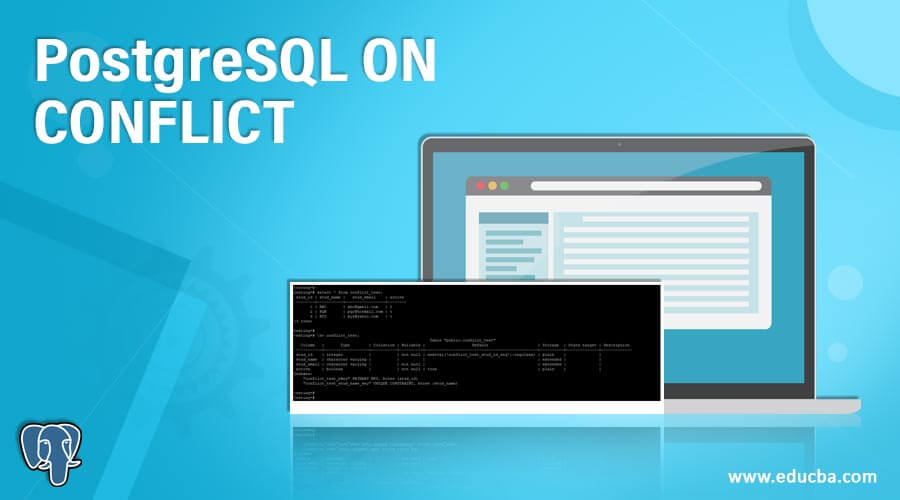

Note: If we are using an earlier version of PostgreSQL, we will need a workaround to have the upsert feature as the ON CONFLICT clause is only accessible from PostgreSQL 9.5.
POSTGRESQL INSERT CONFLICT UPDATE
This action is used to update some fields in the table. It defines that we do nothing if the row already presents in the table.ĭO UPDATE SET column_1 = value_1. In the above command, the Conflict_action can be one of the following: Actions In this, the constraint name could be the name of the UNIQUE constraint. For example, to update the temperature and humidity values if a row with the specified. It is used to specify a column name in the particular table. In the above command, the Conflict_target can be one of the following: Target You can use the excluded table alias which includes all rows that failed to insert because of conflicts: INSERT INTO blogsums ( blogid, date, totalcomments) SELECT blogid, '', count (commentid) as totalcommentsupdate FROM blogcomments. Then INSERT and SELECT come up empty.For supporting the upsert attribute, the PostgreSQL added the ON CONFLICT target action clause to the INSERT command. Concurrent transactions may have added a conflicting row, which is not yet visible in the same statement. You cannot access the column aliases from the select in the DO UPDATE SET clause. Concurrent transactions may have added a conflicting row, which is not yet visible in the same statement. However, there is still a tiny corner case for a race condition. This would make the operation more expensive, add to possible concurrency issues / lock contention in certain situations and bloat the table additionally. I assume you are aware that in Postgres every UPDATE writes a new version of the row due to its MVCC model - even if name is set to the same value as before. This way you do not actually write a new row version without need. The ON CONFLICT specifies alternative action to be taken in case of conflict occurring during the insert operation. WHERE name = 'bob' - only executed if no INSERT

WHERE FALSE - never executed, but locks the row Upserting data is relatively easy in PostgreSQL because of the ON CONFLICT, ON CONSTRAINT, DO NOTHING, and DO UPDATE SET parts of the INSERT statement. Thankfully, PostgreSQL makes it super easy to turn any insert statement into an upsert, using the on conflict condition. For example, table 'reports' has 3 columns, so far I have the following: INSERT INTO reports (col2, col3) VALUES (1, 2) ON CONFLICT ON CONSTRAINT customindex DO SELECT FROM reports WHERE col11 AND col22 For those who will ask, customindex was created using: CREATE UNIQUE INDEX customindex ON reports (col2) INCLUDE (col3) The. The new UPSERT functionality in Postgres 9.5 is still instrumental. I want an insert statement for entries that skips insertion if either the entryid already exists or the referenced item does not exist. It's the recurring problem of SELECT or INSERT, related to (but different from) an UPSERT. What is the reasoning for not allowing the (my) desired behaviour? ON CONFLICT ON CONSTRAINT names_name_key DO UPDATE In order to have it function as desired I would actually need to: INSERT INTO names(name) VALUES ('bob') So, in the above example, it wouldn't return anything. However, RETURNING only returns either inserted or updated rows. ON CONFLICT (name) DO NOTHING RETURNING idĪnd have it return bob's id 1. Or perhaps: INSERT INTO names(name) VALUES ('bob') Before the DBMS can do anything with the data, it's.
POSTGRESQL INSERT CONFLICT SERIAL
A SERIAL column in Postgres is implemented as a DEFAULT which executes the nextval() function on a bound SEQUENCE.

Then I'd like to: INSERT INTO names(name) VALUES ('bob') Check values to insert against constraint If duplicate detected, abort Increment sequence Insert data But in fact, the increment has to happen before the insert is attempted. INSERT INTO answer VALUES (1,1,'q1') ON CONFLICT ON CONSTRAINT answerpk DO UPDATE SET answer EXCLUDED.answer When the constraint changes in the future you don't need to manually adjust the insert statements to reflect this. I have a situation where I very frequently need to get a row from a table with a unique constraint, and if none exists then create it and return.įor example my table might be: CREATE TABLE names(


 0 kommentar(er)
0 kommentar(er)
